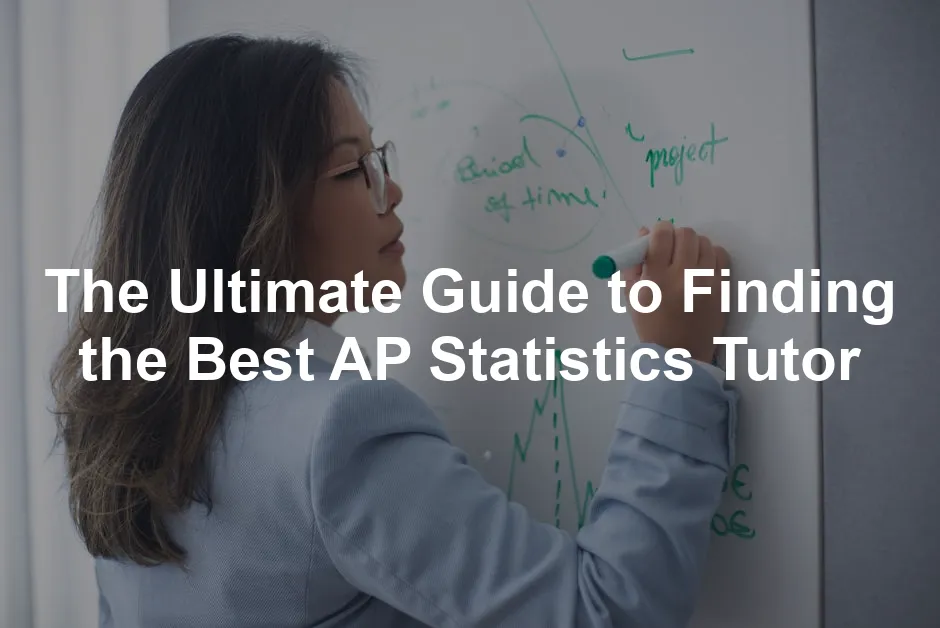Introduction
AP Statistics is a vital component of high school education. It equips students with essential skills for analyzing data and making informed decisions. In today’s data-driven world, understanding statistics is more crucial than ever. This course covers various topics, including data analysis, probability, and statistical inference. Mastering these concepts can open doors to college-level courses and career opportunities.
However, AP Statistics is not a walk in the park. Many students find themselves struggling with intricate statistical concepts. This is where a tutor can make a significant difference. Personal tutoring offers tailored instruction that can simplify the complexities of the subject. It helps students not just grasp difficult concepts but also boosts their confidence before the exam.
In this article, we will discuss the benefits of hiring an AP Statistics tutor. You’ll learn about the key concepts covered in the course, such as measures of central tendency, sampling distributions, and confidence intervals. Furthermore, we’ll provide you with tips on how to choose the right tutor for your needs. Whether you’re seeking help to ace the exam or simply to improve your understanding, this guide is here to illuminate your path to success in AP Statistics.

Why You Need an AP Statistics Tutor
The Challenges of AP Statistics
AP Statistics can be a real brain teaser. Many students find it challenging due to the depth and breadth of topics it covers. Statistical inference, data interpretation, and probability can make heads spin. Imagine trying to understand cumulative frequency while also grappling with sampling distributions. It’s no wonder many students feel overwhelmed!
Statistics involves interpreting data and drawing conclusions based on evidence. For instance, understanding how to calculate and interpret confidence intervals can be daunting. Students often struggle with the nuances of different types of data and how to analyze them correctly. The concepts can feel abstract, making it tricky for students to relate them to real-life situations.
Another common hurdle is the language of statistics. Students may find the terminology confusing. Words like “variance,” “standard deviation,” and “hypothesis testing” can sound like a foreign language. This confusion can hinder their ability to grasp the subject fully.
Without proper guidance, these challenges can lead to frustration and lower performance on exams. However, an AP Statistics tutor can help students navigate these complexities. They can provide personalized explanations and tackle specific areas where a student may struggle. A tutor’s support can transform a daunting subject into an engaging learning experience.
In summary, the road to mastering AP Statistics is paved with challenges. But with the right tutor by your side, you can overcome these obstacles and excel in your studies.

Benefits of Tutoring
Finding the right AP Statistics tutor can transform a student’s learning experience. Here are some key benefits:
- Personalized Learning Plans
Every student is unique. Tutors create customized learning plans. These plans cater to individual strengths and weaknesses. Whether a student struggles with probability or sampling techniques, the approach is tailored to meet their needs. This personalized touch makes a world of difference. Plus, you can dive deeper into essential resources like the AP Statistics Crash Course Book to solidify your understanding. - Flexibility in Scheduling and Learning Pace
Life is busy, especially for high school students. Tutors offer flexibility in scheduling. Students can choose sessions that fit their calendar. This means no more rushing through homework just to meet a tutor. Plus, they can learn at their own pace. If a concept takes longer to grasp, the tutor adjusts accordingly. - Increased Confidence and Improved Grades
Nothing boosts confidence like understanding a tough subject. With the right guidance, students often see their grades improve. They feel more prepared for tests and class discussions. A confident student is a successful student. Many report feeling less anxious about the AP exam after working with a tutor. To enhance your study sessions, consider using a Graphing Calculator (TI-84 Plus) to tackle complex problems. - Access to Expert Knowledge and Resources
Tutors come with a wealth of knowledge. Many have advanced degrees in mathematics or statistics. They share valuable resources, from practice problems to study guides. This access can be a game-changer. Students not only learn concepts but also how to apply them in real-world situations. For example, the Barron’s AP Statistics book can be an excellent resource.

Key Concepts Covered in AP Statistics
Exploring Data
In AP Statistics, data exploration lays the groundwork for analysis. Students learn to interpret graphical representations. Histograms and boxplots are key tools for visualizing data. Histograms show the distribution of data points, highlighting frequency. Boxplots, on the other hand, reveal median, quartiles, and outliers effortlessly.
Measures of central tendency are also crucial. Students become familiar with mean, median, and mode. Understanding these concepts helps in summarizing data effectively. For instance, the mean provides a quick snapshot of the dataset, while the median offers insights into skewed data. Together, these measures empower students to describe datasets convincingly. To dive deeper into the subject, check out The Art of Statistics: Learning from Data.
Alongside these measures, variability is examined. Concepts like range, variance, and standard deviation help quantify data spread. This understanding is essential for making informed conclusions. Students learn to assess how data points differ from the average, enhancing their analytical skills.

Probability and Sampling
Probability is the heart of statistics. AP Statistics introduces students to random variables and sampling distributions. A random variable represents possible outcomes of a random process. Understanding this concept is vital for grasping more complex topics later on.
Sampling distributions come into play when discussing the Central Limit Theorem. This theorem states that, given a sufficiently large sample size, the sampling distribution will approximate a normal distribution. This is significant for making predictions about populations based on sample data. Learn more about why the Central Limit Theorem is important.
Students learn various sampling methods. Simple random sampling, stratified sampling, and cluster sampling each have unique benefits. Knowing when to use each method enhances the quality of statistical analysis.
Through these lessons, students build a solid foundation in probability. They learn to calculate probabilities using formulas and tables. This skill is indispensable for hypothesis testing and making data-driven decisions.
Mastering these concepts not only prepares students for the AP exam but also equips them with analytical skills applicable in various fields. With a solid grasp of exploring data and understanding probability, students are well on their way to statistical mastery.

Statistical Inference
Statistical inference is a core component of AP Statistics. It empowers students to make predictions and decisions based on data. Two key concepts here are hypothesis testing and confidence intervals.
Hypothesis Testing
This process helps determine if there’s enough evidence to support a specific claim about a population. Students learn how to formulate null and alternative hypotheses. They then use sample data to make inferences about the population. A classic example is testing if a new teaching method improves student scores. Check out our comprehensive guide on hypothesis testing.
Confidence Intervals
A confidence interval provides a range of values, likely containing the population parameter. For instance, if a survey indicates that 60% of students prefer online learning, a confidence interval might show that this percentage could realistically be between 55% and 65%. Understanding confidence intervals helps students appreciate the uncertainty in estimates.
Significance Tests
These tests help assess the strength of the evidence against the null hypothesis. A low p-value indicates strong evidence against the null hypothesis, while a high p-value suggests otherwise. Students often grapple with these concepts, making a solid understanding crucial for success. For additional insights, consider reading Statistics for Dummies.

Data Analysis Techniques
In AP Statistics, students learn various techniques for analyzing data, both quantitative and categorical. These techniques are vital for interpreting data effectively. Discover more about data analysis techniques for economics and statistics students.
Quantitative Data Analysis
This involves analyzing numerical data. Techniques include calculating measures of central tendency like mean, median, and mode. Students also study variability with range, variance, and standard deviation. These measures help summarize data sets succinctly.
Categorical Data Analysis
For categorical data, students explore frequency tables and bar charts. They learn how to summarize data by calculating proportions and percentages. This allows for comparisons between different groups. For instance, comparing the proportion of students who prefer different study methods can reveal valuable insights.
Using Software Tools
Students are often introduced to software tools that facilitate data analysis. Learning to use programs like Excel or statistical software can enhance their analytical skills. These tools help visualize data and conduct complex analyses efficiently. If you’re new to Excel, check out Excel 2021 for Dummies for a great introduction.
By mastering these data analysis techniques, students enhance their ability to interpret real-world data, which is crucial in many fields. With a solid foundation in statistical inference and data analysis, students are well-prepared for success in AP Statistics and beyond.

Assessing Tutor Availability and Flexibility
Finding an AP Statistics tutor who is available around the clock can be a game changer. Imagine needing help with a tricky problem at 10 PM. With 24/7 online tutoring options, that’s no longer a problem! You can connect with an expert tutor any time of day or night. This flexibility means you’re not bound by traditional tutoring hours. You can study when it works best for you, whether that’s early in the morning or late at night.
Platforms such as Tutor.com and Varsity Tutors allow students to access their services whenever they need assistance. Tutor.com boasts a wide range of subjects and offers the convenience of on-demand help. You can log on and get immediate support for AP Stats concepts, from hypothesis testing to confidence intervals. Similarly, Varsity Tutors provides a flexible online environment where students can schedule sessions at their convenience, ensuring they receive the help they need, when they need it.

Evaluating Teaching Style
Every student learns differently, and that’s where the teaching style of your tutor comes into play. A tutor’s approach can significantly impact how well you grasp complex concepts. Some tutors might use a straightforward lecture style, while others may prefer interactive methods, incorporating games or visual aids.
When searching for an AP Statistics tutor, look for someone who tailors their teaching to your learning style. For example, if you thrive on interaction, find a tutor who emphasizes discussion and hands-on problem-solving. This type of personalized approach can make a world of difference. Many students find that interactive sessions not only enhance understanding but also make learning more enjoyable. So, seek out a tutor who can turn those dry statistics lessons into an engaging learning experience!

Varsity Tutors: Personalized Learning Plans and Success Stories
When it comes to mastering AP Statistics, Varsity Tutors stands out with its personalized learning plans. They understand that every student has unique learning styles and paces. That’s why they craft tailored tutoring experiences. Each plan is designed to meet specific needs, focusing on areas where students may struggle the most.
Imagine a student grappling with probability concepts. A Varsity tutor will zero in on that, providing targeted exercises and explanations. This individualized attention helps students grasp complex topics, making them feel more confident. For additional reading, consider The Signal and the Noise: Why So Many Predictions Fail—But Some Don’t.
Success stories from Varsity Tutors further illustrate their effectiveness. One student, Sarah, was failing her AP Stats class. After just a few weeks of tutoring, she improved her grade from a D to a B+. She couldn’t believe her transformation! Another student, Jake, who used to dread statistics, now looks forward to his AP exam. Thanks to his tutor’s engaging methods, he’s aced practice tests.
These stories aren’t just rare occurrences. Varsity Tutors boasts a high satisfaction rate among its students. Ninety percent of their students report improved grades after working with their tutors. This level of success showcases how personalized learning plans can lead to significant academic achievements.
If you’re looking for a supportive, engaging environment to tackle AP Statistics, Varsity Tutors is a fantastic choice. With their commitment to tailored education and proven success stories, they’re ready to help students excel.

Additional Resources for AP Statistics Students
AP Statistics students can benefit greatly from various online resources. Khan Academy offers a treasure trove of instructional videos and practice exercises. This platform breaks down complex topics, making them easier to digest. For a more visual approach, consider The Cartoon Guide to Statistics which presents concepts in a fun and engaging way.
Educational YouTube channels also provide valuable content. Channels like StatQuest and Crash Course Statistics present concepts in an entertaining way. They combine humor with education, keeping students engaged while learning.
Furthermore, study groups can be excellent for peer support. Students can share insights, tackle challenging problems, and motivate each other. Online forums, like Reddit’s r/APStudents, allow learners to connect with peers facing similar challenges. These platforms provide a space for discussion, advice, and encouragement.
Incorporating these resources can enhance a student’s understanding of AP Statistics. With the right tools and support, anyone can master the art of statistics and ace their exams! For a foundational text, consider Understanding Statistics: An Introduction.

Please let us know what you think about our content by leaving a comment down below!
Thank you for reading till here 🙂
All images from Pexels




